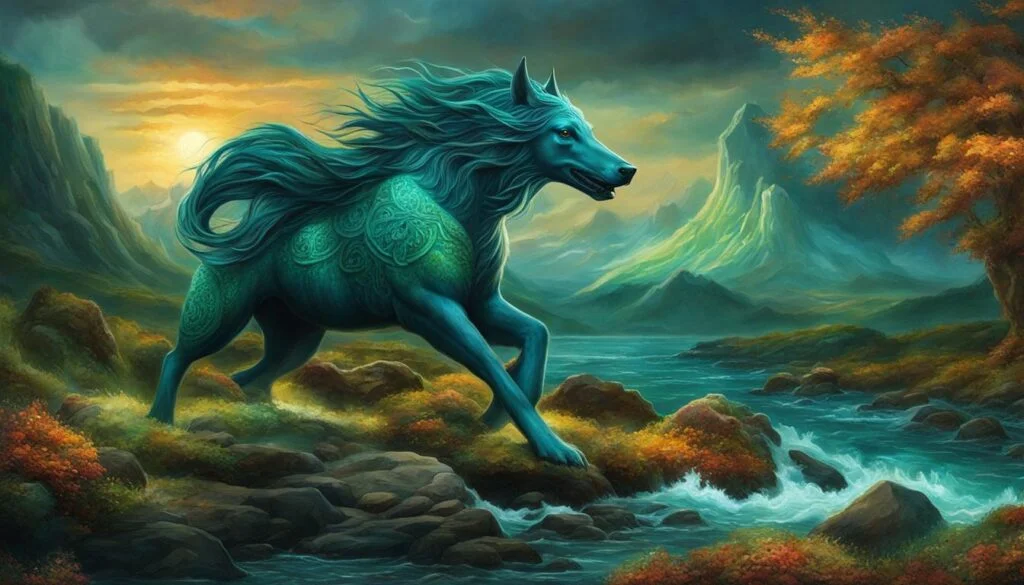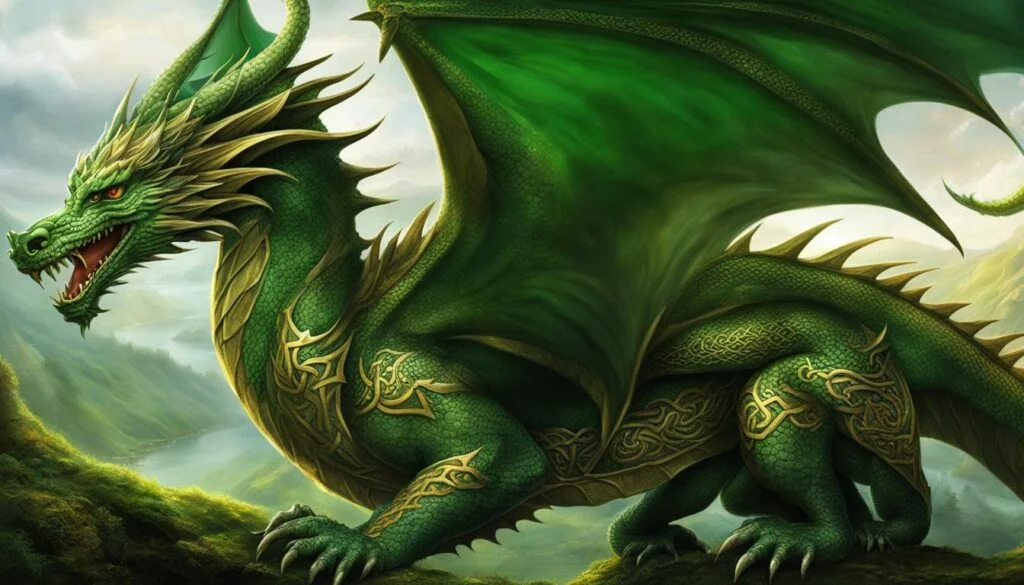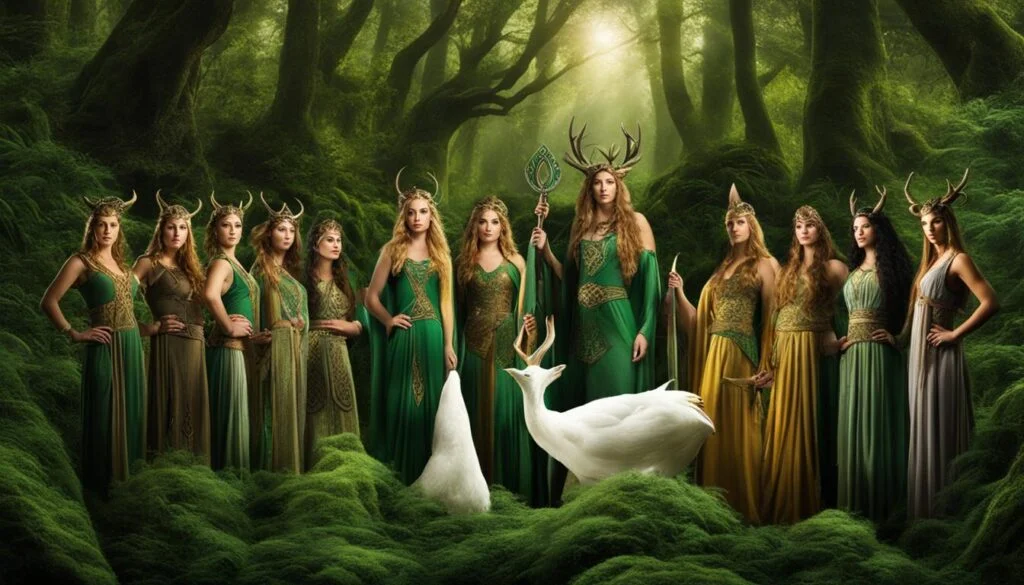When we think of Celtic mythology, enchanting creatures and mythical beings often come to mind. One such creature that has captured our imagination is the elf. But are there really elves in Celtic mythology? Let’s delve into the world of Celtic folklore and discover the fascinating connection between the Sidhe and elves.
Key Takeaways:
- Elves in Celtic mythology are closely associated with the Sidhe, ethereal beings of Celtic folklore who dwell in ancient mounds and hills.
- The Sidhe are believed to be guardians of the land and have a deep connection to nature, much like the portrayal of elves in popular culture.
- The origins of elves can be traced back to various mythologies, including Norse mythology and Germanic folklore, but it is within Celtic mythology that we find a profound connection.
- Celtic folklore is filled with enchanting beings that embody qualities reminiscent of elves, such as fairies, sprites, and leprechauns.
- The enduring mystique of elves lies in their timeless allure and the fascination they continue to evoke in our collective consciousness.
The Origins of Elves
In the realm of mythology, the origins of elves can be traced back to various cultures and belief systems. Norse mythology is one such source where elves, known as the Álfar, were associated with nature, fertility, and magic. These elves were revered as ethereal beings who dwelled in forests and possessed a deep connection to the natural world. Similarly, Germanic folklore depicted elves as small, mischievous creatures with supernatural powers. These folklore elves often played tricks on humans but also had the ability to bestow good fortune.
However, it is within Celtic mythology that we find a profound connection between elves and their origins. The Celtic culture, which thrived during the Iron Age and beyond, held a deep reverence for nature and the spiritual world. The Sidhe, often equated with elves, are ethereal beings of Celtic folklore who embody beauty, grace, and a deep connection to nature. They were believed to inhabit ancient mounds and hills, serving as guardians of the land and keepers of ancient wisdom.
The Influence of Norse Mythology and Germanic Folklore
- In Norse mythology, elves, known as the Álfar, were associated with nature, fertility, and magic.
- Germanic folklore depicted elves as small, mischievous creatures with supernatural powers.
The Connection to Celtic Mythology
The Sidhe, often equated with elves, are ethereal beings of Celtic folklore who embody beauty, grace, and a deep connection to nature. They were believed to inhabit ancient mounds and hills, serving as guardians of the land and keepers of ancient wisdom.
As Celtic mythology influenced the portrayal of elves in various cultures, the image and characteristics of these mythical beings evolved over time. The enduring fascination with elves is a testament to their timeless allure and the enduring influence of ancient mythologies.
The Influence of Celtic Mythology on Elves
Elves hold a prominent place in Celtic folklore, with their origins deeply intertwined with the mythological beings known as the Sidhe. The Sidhe, also referred to as the People of the Mounds, are ethereal creatures associated with beauty, magic, and a profound connection to nature. They are revered as guardians of the land and are often associated with specific locations such as fairy mounds or “sidhe,” which are believed to serve as portals between the mortal realm and the Otherworld.
The Sidhe: Guardians of the Land
The Sidhe play a significant role in Celtic mythology and have shaped the portrayal of elves in popular culture. They embody the essence of the mystical and enchanting creatures that captivate our imagination. The cultural significance of the Sidhe is evident in ancient Celtic society, where their reverence as guardians of the land influenced the depiction of elves in Celtic folklore. As tales were passed down through generations, the image of elves expanded and transformed, leaving an indelible mark on our perception of these mythical beings.
An Enduring Cultural Influence
The influence of Celtic mythology extends beyond the Sidhe. Celtic folklore is filled with a diverse array of enchanting beings that share similarities with elves. Fairies, sprites, and leprechauns are mythical creatures deeply rooted in Celtic culture, embodying qualities reminiscent of elves. These creatures serve as symbols of nature, magic, and the supernatural, reflecting the Celtic people’s deep respect for the natural world and their belief in the interconnectedness between realms.
- The Sidhe, or People of the Mounds, are ethereal creatures associated with beauty, magic, and a deep connection to nature.
- They are revered as guardians of the land and are often associated with specific locations such as fairy mounds or “sidhe”.
- Elves in Celtic folklore draw inspiration from the Sidhe, embodying their ethereal qualities and mystical allure.
- Celtic folklore features a rich tapestry of enchanting beings such as fairies, sprites, and leprechauns, sharing similarities with elves.
As we delve deeper into the realms of Celtic mythology, we uncover a world graced by the presence of elves and other mythical creatures. Their enduring influence on our culture and imagination serves as a testament to the power of folklore and the timeless appeal of enchanting beings.
Celtic Mythology: Exploring Ancient Deities and Enchanting Beings
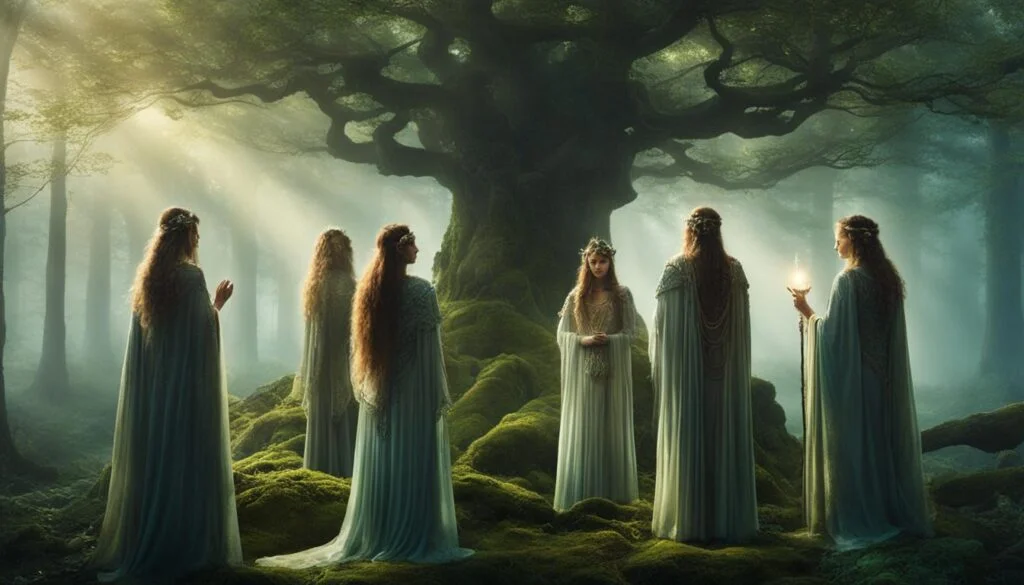
Celtic mythology is a treasure trove of captivating tales and mystical creatures that have enchanted generations. At the heart of this extraordinary mythology are the ancient deities and enchanting beings that hold sway over the natural and supernatural realms. These divine entities and ethereal creatures are deeply rooted in the Celtic culture, reflecting the profound reverence that the Celtic people had for nature and its spiritual connections.
One of the most prominent figures in Celtic mythology is the Dagda, the great god associated with abundance, wisdom, and fertility. Known as the “Good God,” the Dagda embodies the essence of the natural world, commanding the elements and overseeing the cycles of life and death. His presence is often depicted in the tales of ancient Ireland, where he wields his mighty club, controls the seasons, and brings prosperity to the land.
Ancient Celtic Deities
- The Morrigan: The goddess of war, sovereignty, and prophesy, the Morrigan is a complex and enigmatic figure. Often portrayed as a shape-shifter, she appears as a cow, a crow, or a mysterious woman. The Morrigan plays a pivotal role in Celtic mythology, guiding and influencing the fate of both mortals and gods.
- Brigid: The goddess of poetry, healing, and smithcraft, Brigid is a beloved figure in Celtic mythology. Revered as the keeper of the sacred flame and the patroness of creativity, she represents the powerful forces of inspiration and transformation.
These ancient deities, along with countless others, weave a tapestry of enchantment and wonder in Celtic mythology. Their stories and powers are woven into the fabric of the Celtic culture, providing a glimpse into a world where gods and mortals coexist, and the natural and supernatural realms intertwine.
The enchanting beings of Celtic mythology are equally captivating. From mischievous fairies to wise druids, these mythical creatures add depth and intrigue to the folklore of the Celts. Fairies, known as “Síóg” in Celtic, are often depicted as ethereal beings with supernatural powers. They are associated with natural elements such as waterfalls, meadows, and ancient trees.
Overall, the rich tapestry of Celtic mythology is a testament to the deep connection between the Celtic people and the natural world. It is a world filled with ancient deities and enchanting beings that continue to inspire and captivate us today.
The Sidhe: Akin to Elves
In Celtic mythology, the Sidhe are mystical beings often equated with elves in modern folklore. They share remarkable similarities with the popular depiction of elves, embodying beauty, magic, and a deep affinity for nature. The Sidhe are believed to inhabit the Otherworld, a parallel realm to our own, and are revered as guardians of the land.
Like elves, the Sidhe possess ethereal and otherworldly qualities. Their radiating beauty and enchanting presence captivate those fortunate enough to encounter them. The Sidhe’s association with specific locations, such as fairy mounds or “sidhe,” further establishes their connection to the natural world and serves as a portal between the mortal realm and the Otherworld.
The Similarities Between Sidhe and Elves:
- Both associated with beauty, magic, and a deep affinity for nature.
- Believed to inhabit a parallel realm to our own.
- Revered as guardians of the land.
- Radiate an otherworldly beauty and enchanting presence.
- Associated with specific locations serving as portals between realms.
The Sidhe’s resemblance to elves underscores the enduring influence of Celtic mythology on the portrayal of these mythical beings in popular culture. Whether through ancient tales or contemporary stories, the Sidhe and elves continue to captivate our imagination, weaving a sense of wonder and mystery into our cultural consciousness.
Elves in Celtic Folklore: Enchanting Beings of Myth and Legend
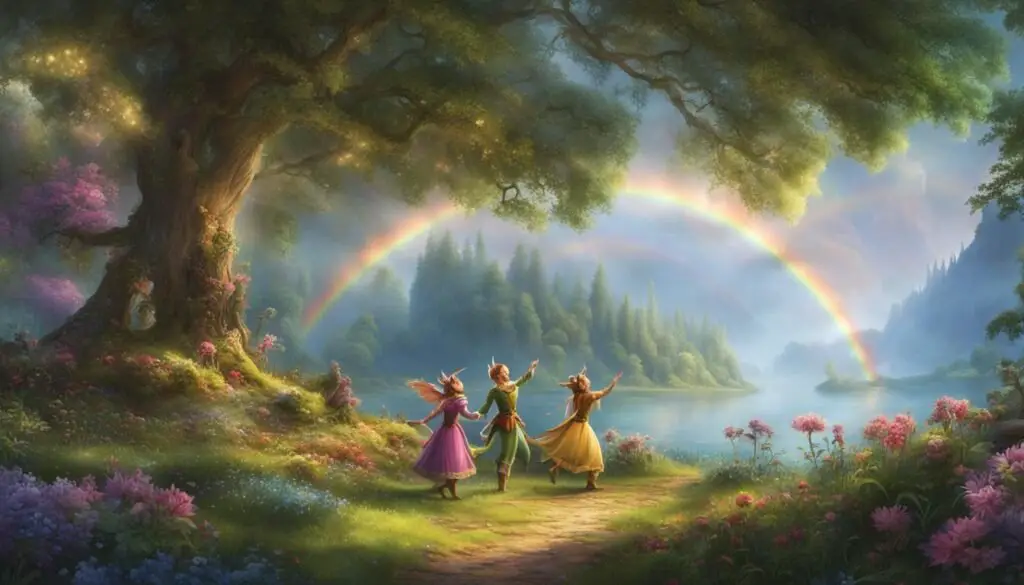
In Celtic folklore, elves are enchanting beings that captivate the imagination with their magical qualities and connection to the natural world. They are part of a rich tapestry of mythical creatures that populate Celtic mythology, alongside fairies, sprites, and leprechauns. These magical beings play diverse roles in tales and legends, often associated with the guardianship of nature and the supernatural. While elves share certain similarities with the popular image of these mythical beings, they possess unique characteristics rooted in the Celtic culture and its deep reverence for the natural world.
The portrayal of elves in Celtic folklore reflects the enduring allure and captivating nature of these mythical creatures. They are depicted as graceful and otherworldly, with a deep affinity for nature and a penchant for both mischief and helpfulness. In tales that have been passed down through generations, elves are often associated with specific locations such as fairy mounds or sacred hills, serving as portals between the mortal realm and the Otherworld. The ethereal and mystical qualities of elves in Celtic folklore transport us to a world where wonder and magic intertwine.
The Role of Elves in Celtic Mythology
- Guardians of nature: Elves are closely associated with the natural world and are often portrayed as guardians of the land, protecting its beauty and balance.
- Mischievous tricksters: Elves are known for their mischievous nature, playing pranks on humans and sometimes leading them astray.
- Helpful spirits: Elves can also be portrayed as benevolent beings, providing assistance and guidance to those who show them respect and reverence.
- Cultural significance: Elves hold a significant place in Celtic culture, symbolizing the ethereal and magical aspects of the human imagination.
The enchanting beings of Celtic folklore, including elves, continue to inspire and captivate audiences worldwide. Their enduring presence in myths, legends, and popular culture is a testament to the timeless allure and cultural significance of these mystical creatures.
Related Articles:
- The Origins of Elves in Norse Mythology
- The Influence of Celtic Mythology on Modern Fantasy
- The Evolution of Elves in Popular Culture
The Evolution of Elves in Modern Media
Elves have undergone a remarkable evolution in modern fantasy literature, movies, and games. Their portrayal in popular culture has evolved and expanded, capturing the imaginations of audiences worldwide. From their origins in Celtic mythology to the works of J.R.R. Tolkien and beyond, elves have become iconic figures in the realm of fantasy.
One of the key influences on the modern portrayal of elves is the rich mythology of Celtic folklore. The ethereal beauty, extraordinary skills, and connections to nature that are characteristic of elves can be traced back to the ancient Celtic belief in the Sidhe. These enchanting beings, often equated with elves, have left an indelible mark on modern representations of these mythical creatures.
In addition to Celtic mythology, other sources such as Norse mythology and Germanic folklore have also contributed to the evolution of elves in modern media. The vibrant and diverse world of Dungeons & Dragons, for example, features elves with distinct cultural backgrounds, abilities, and appearances. These different portrayals and interpretations have added depth and complexity to the concept of elves, allowing for a wide range of storytelling possibilities.
Whether they are depicted as graceful warriors, wise scholars, or mischievous tricksters, the modern portrayal of elves reflects our enduring fascination with these mythical beings. Their evolution in popular culture showcases the enduring enchantment and allure of elves, while paying homage to their Celtic origins. As we continue to explore new realms of imagination, elves will undoubtedly remain a beloved and integral part of our collective storytelling tradition.
Elves in Popular Culture
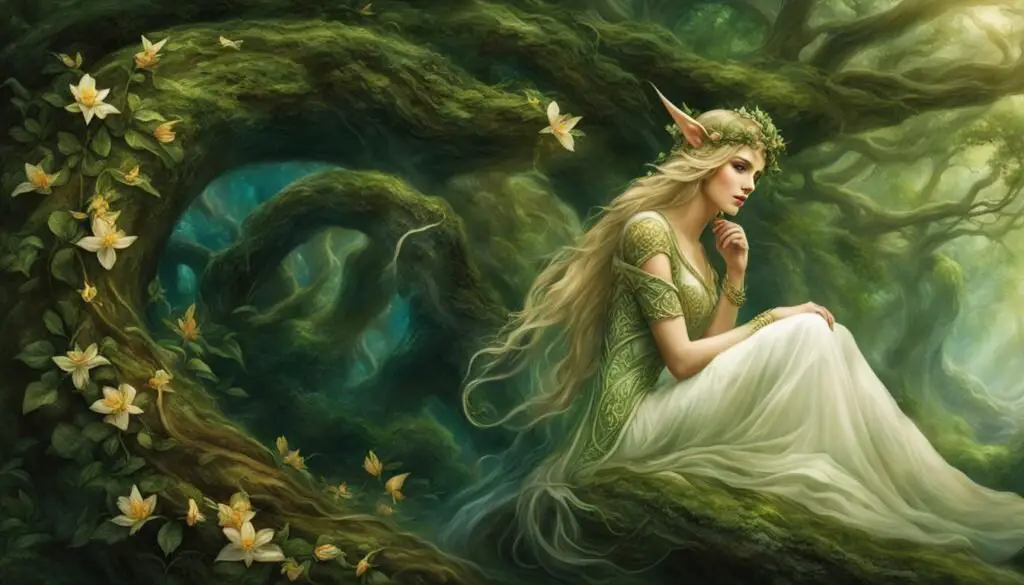
Elves have captured our collective imagination and have become iconic figures in popular culture. They have found their way into various forms of media, including books, movies, and video games, enchanting audiences with their graceful presence and mystical abilities. Throughout the years, elves have been portrayed as beings of ethereal beauty, long life, and a deep connection to nature.
In movies like “The Lord of the Rings” and “Harry Potter,” elves are depicted as wise and powerful beings with a profound understanding of magic. In fantasy literature, authors like J.R.R. Tolkien have created intricate worlds where elves play central roles, showcasing their exceptional skills and captivating allure. Elves have also made their mark in the gaming industry, appearing in popular video games like “The Elder Scrolls” series and “World of Warcraft.”
From their origins in Celtic mythology to their modern-day portrayals, the enduring appeal of elves lies in their connection to nature and the supernatural. Their portrayal in popular culture draws inspiration from the rich tapestry of Celtic folklore, allowing us to immerse ourselves in a world where magic and wonder intertwine. Whether they are portrayed as noble and wise guardians or mischievous tricksters, elves continue to captivate audiences around the world, reminding us of the timeless allure of mythical creatures.
The Cultural Significance of Elves
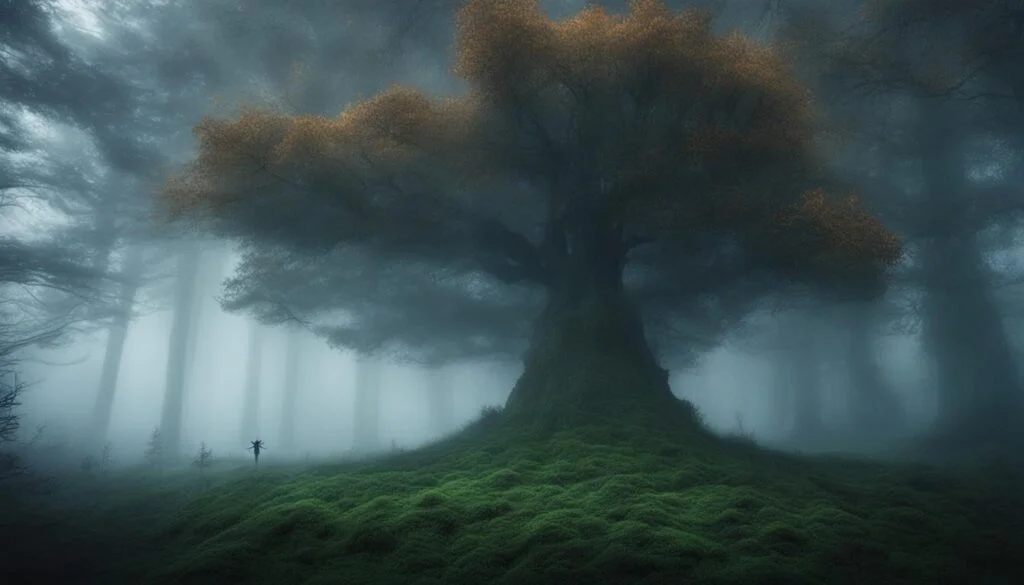
Elves have played a significant role in folklore and legends across cultures, captivating the human imagination with their ethereal qualities and magical abilities. These enchanting beings hold a deep cultural significance, representing our inherent connection to nature and the supernatural. In various mythologies, elves embody traits such as beauty, wisdom, and immortality, symbolizing the wonders and mysteries beyond our reach.
The Cultural Significance of Elves:
- Elves are mythical beings that evoke a sense of wonder and enchantment.
- They represent a connection to the ethereal and magical aspects of our collective consciousness.
- Throughout history, elves have been associated with beauty, wisdom, and immortality.
- They symbolize our deep reverence for nature and the supernatural.
- The cultural significance of elves extends beyond their portrayal in myths and stories, resonating with our desire for a connection to the mystical realm.
Elves in folklore and legends provide a glimpse into the rich tapestry of human imagination, offering a bridge between the mundane and the extraordinary. They serve as a reminder of the magical possibilities that exist beyond the realms of our everyday lives. The enduring fascination with elves reflects our innate yearning for the wonders and mysteries that lie just beyond our grasp.
By exploring the cultural significance of elves in folklore and legends, we gain a deeper understanding of our collective fascination with these mythical beings. Whether they appear as mischievous tricksters or wise guardians of nature, elves continue to captivate our imaginations, reminding us of the enduring power of storytelling and the timeless allure of the enchanting and mysterious realms that lie beyond our own.
The Enduring Mystique of Elves
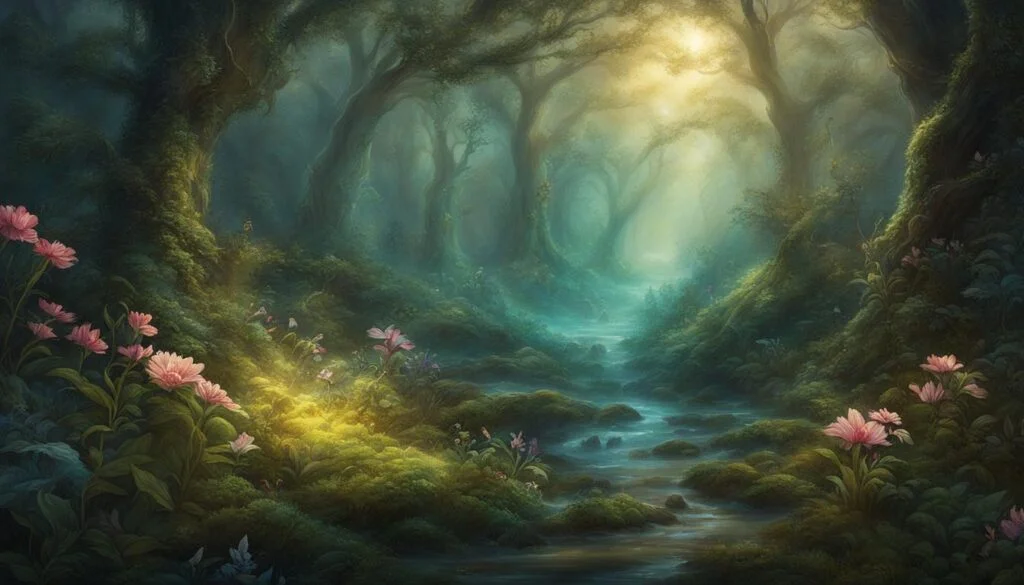
Elves have captivated our imaginations for centuries, and their mystique continues to endure. These ethereal beings possess an otherworldly beauty and magical abilities that have fascinated us throughout mythology, folklore, and popular culture. The enduring fascination with elves can be attributed to their connection to nature, their mysterious origins, and their representation of the ethereal and magical aspects of the human imagination.
The Connection to Nature
One of the key elements that contribute to the enduring allure of elves is their deep connection to the natural world. In Celtic mythology, the Sidhe are revered as guardians of the land and are associated with specific locations such as fairy mounds. This connection to nature resonates with our innate desire for a deeper connection to the world around us. Elves embody the beauty and mystery of the natural world, allowing us to escape into a realm where magic and wonder coexist.
The Mysterious Origins
The origins of elves have intrigued us for centuries, with various mythologies offering different interpretations. In Celtic mythology, the Sidhe are believed to inhabit the Otherworld, a parallel realm to our own. This sense of mystery and the unknown surrounding elves fuels our fascination and desire to unravel their secrets. The enduring mystique of elves lies in their enigmatic beginnings, allowing us to envision a world where the boundaries between reality and the supernatural are blurred.
The Ethereal and Magical
Elves embody the ethereal and the magical, captivating our imaginations with their graceful presence and extraordinary abilities. From Tolkien’s enchanting elves to the modern portrayals in books, movies, and video games, these mythical beings continue to charm and inspire us. Their portrayal in popular culture reflects our collective fascination with the mystical and the extraordinary. The enduring mystique of elves lies in their ability to transport us to a world where the magical and the mundane collide, leaving an indelible mark on our cultural consciousness.
Conclusion
In conclusion, elves in Celtic mythology, particularly the Sidhe, hold a significant place in the folklore and legends of ancient Celtic culture. Their deep connection to nature, ethereal beauty, and magical abilities have captivated the imagination of generations. The influence of Celtic mythology on the portrayal of elves in modern media is undeniable, as it shapes our understanding and perception of these enchanting creatures.
From their origins in Norse mythology and Germanic folklore to their embodiment in Celtic mythology, elves have evolved and transformed throughout history. Their portrayal in popular culture reflects the enduring appeal and fascination with these mythical beings. The enduring mystique of elves lies in their timeless allure and the desire for a connection to the enchanting and mysterious realms beyond our reach.
Whether in ancient tales or contemporary stories, the enduring presence and cultural significance of elves continue to inspire and captivate audiences worldwide. Their portrayal in mythologies and popular culture serves as a reminder of the enduring power of ancient folklore and the timeless allure of Celtic mythology.
FAQ
Are elves mentioned in Celtic mythology?
Yes, the concept of elves in Celtic mythology is closely associated with the Sidhe, beings that are often equated with elves in modern folklore.
What are the Sidhe?
The Sidhe are ethereal creatures of Celtic folklore who dwell in ancient mounds and hills. They are known for their beauty, grace, and magical abilities.
What is the connection between the Sidhe and nature?
The Sidhe are believed to be guardians of the land and have a deep connection to nature. They are associated with specific locations such as fairy mounds or “sidhe” which are believed to serve as portals between the mortal realm and the Otherworld.
Where do the origins of elves come from?
The origins of elves can be traced back to various mythologies, including Norse mythology and Germanic folklore.
How do the Sidhe resemble modern depictions of elves?
The Sidhe, often equated with elves, are beautiful, magical creatures with a deep affinity for nature. They are believed to inhabit the Otherworld, a parallel realm to our own.
What are some other magical creatures in Celtic mythology?
Celtic folklore is filled with enchanting beings such as fairies, sprites, and leprechauns, each with their own unique roles and characteristics.
How have elves evolved in modern media?
Elves have undergone a remarkable transformation in modern fantasy literature, movies, and games, with influences from Celtic mythology shaping their portrayal.
How are elves portrayed in popular culture?
Elves are often depicted as graceful, magical beings with a deep connection to nature. Their portrayal in popular culture draws inspiration from Celtic mythology and captivates audiences worldwide.
What is the cultural significance of elves?
Elves hold a significant place in folklore and legends across cultures, representing the ethereal and magical aspects of the human imagination.
What is the enduring mystique of elves?
The enduring mystique of elves lies in their timeless allure and the fascination they continue to evoke, captivating our imagination with their ethereal qualities, magical abilities, and connection to nature.


